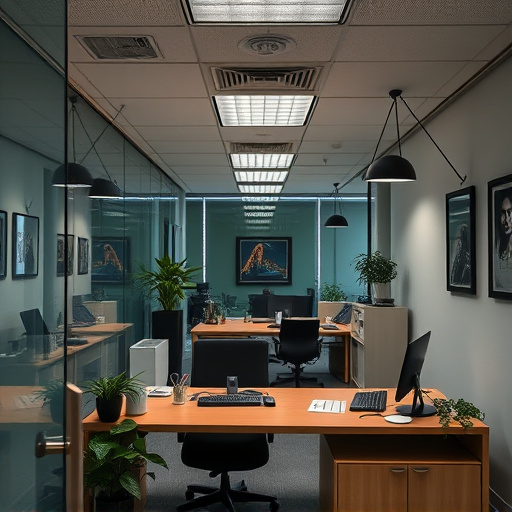Office hidden cameras offer businesses and homeowners discrete security solutions, with a wide range of types and functionalities available. While they enhance safety through 24/7 monitoring, remote access, and evidence collection, their implementation requires careful consideration of privacy rights and legal frameworks, such as data protection laws and surveillance regulations. Best practices include obtaining consent, clear labeling, restricted use to vital areas, and transparent communication about camera locations, purposes, and data handling, ensuring a balanced approach to security and privacy.
Uncover the world of office hidden cameras—a topic that sparks debate and raises important questions about privacy and security. This comprehensive guide explores the intricate details of these surveillance systems, from their technical aspects to legal and ethical implications. We delve into the various types of hidden camera technology, their advantages and drawbacks, and best practices for implementation. Understand the complex landscape surrounding office hidden cameras and make informed decisions in today’s watchful world.
Understanding Hidden Security Cameras: A Comprehensive Overview
Hidden security cameras, also known as covert or concealed cameras, are a sophisticated tool for surveillance that offers businesses and individuals unparalleled peace of mind. These advanced devices are designed to operate discreetly, often blending seamlessly into their surroundings, making it nearly impossible for subjects to realize they’re being recorded. From high-tech office hidden cameras disguised as everyday objects like pens or plants to miniature HD cameras built into wall sockets, the options are vast and constantly evolving.
This technology has become increasingly accessible, with a wide range of applications across various sectors. Businesses use them to monitor sensitive areas, deter theft and vandalism, and protect valuable assets. In homes, they serve as powerful tools for home security and safety, providing round-the-clock surveillance and evidence in case of intrusions. Understanding the intricacies of hidden security cameras—their types, functionalities, and ethical considerations—is essential before deploying them to ensure maximum benefits while adhering to privacy regulations.
Legal Considerations and Privacy Concerns with Office Hidden Cameras
The use of office hidden cameras raises significant legal and privacy considerations that businesses must carefully navigate. While surveillance can enhance security, protect intellectual property, and aid in investigating misconduct, it also intrudes upon employees’ reasonable expectation of privacy. Many countries have strict regulations governing the installation and operation of hidden cameras in workplaces, emphasizing the need for transparency and legitimate business purposes.
Employers deploying office hidden cameras must adhere to data protection laws and ensure informed consent is obtained from staff members. Cameras should be clearly marked as surveillance equipment and limited to areas necessary for the stated purpose, such as high-value asset security or preventing theft. Failure to comply with these guidelines can result in severe legal repercussions, including privacy breaches, data protection violations, and potential class action lawsuits, further complicating the operational and financial health of the business.
Types of Hidden Camera Technology Used in Commercial Spaces
In the realm of commercial security, hidden camera technology plays a pivotal role in enhancing safety and deterring potential threats. One of the most prevalent types used in offices and commercial spaces is wireless surveillance systems. These cameras offer unparalleled flexibility by eliminating the need for complex wiring, making them ideal for discreet installations. Wireless office hidden cameras can be easily mounted behind pictures, clocks, or even within everyday objects like fire alarms, smoke detectors, and light fixtures.
Another sophisticated option is infrared (IR) technology, which enables covert monitoring in low-light conditions or complete darkness. IR cameras capture heat signatures, allowing for clear images even without visible light. This type of hidden camera is particularly useful for 24/7 surveillance in warehouses, retail stores, and other areas where natural lighting might be limited. Advanced models can also include motion detection features, triggering recording only when activity is detected, thus optimizing storage space and privacy.
Benefits and Drawbacks of Installing Secret Surveillance Equipment
The installation of secret surveillance equipment, commonly known as hidden security cameras, offers a range of benefits for businesses and property owners. One significant advantage is enhanced security and peace of mind. These discreet cameras can deter potential intruders or thieves by making them aware that their actions are being recorded. In the event of an incident, office hidden cameras provide valuable evidence, aiding in the identification of perpetrators and facilitating swift justice. Additionally, they enable remote monitoring, allowing owners to keep a vigilant eye on their premises from afar.
However, there are also drawbacks to consider. Privacy concerns are at the forefront, as secret surveillance can infringe upon individuals’ personal space and privacy rights. This is especially relevant in public spaces or areas where employees may not be aware of being recorded. Furthermore, illegal or unethical use of hidden cameras can lead to serious legal repercussions. The benefits must be carefully weighed against potential violations of privacy laws, and it’s crucial to ensure compliance with local regulations to avoid legal issues and maintain the integrity of surveillance practices.
Ethical Implications and Best Practices for Using Office Hidden Cameras
The use of office hidden cameras raises significant ethical questions and concerns regarding privacy, consent, and employee morale. While they can serve as a tool for enhancing security and surveillance, their deployment must be approached with extreme caution. Employees have a reasonable expectation of privacy in the workplace, and the presence of hidden cameras could create an atmosphere of distrust and anxiety.
Best practices dictate that organizations implementing office hidden cameras should prioritize transparency and open communication. Clearly inform all employees about the camera’s location, purpose, and the extent of surveillance. Ensure any video footage is securely stored, accessed only by authorized personnel for valid business purposes, and regularly deleted to protect sensitive information. Additionally, establish robust policies governing the use of such devices, outlining specific scenarios where cameras are activated and the limitations on their employment to avoid abuse or misuse.
